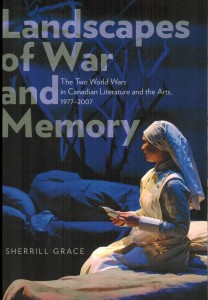Nations at war, glorify war. Otherwise war would be untenable. Remembrance Day observances have seen the Royal B.C. Museum hand out helmets to 7-year olds and have them sit in a jeep. The Calgary Sun assigned a reporter to walk city streets shaming 9 in 10 passersby who failed to wear a poppy. Grade 10 students in Tillsonburg, Ont. were asked to jog through a ditch in a farmer’s field; CTV News Channel called it “a realistic experience about war”.
Canada in the past 12 years has been at war in Afghanistan, Libya and Syria. At the same time officialdom and media have celebrated wartime exploit as a central fixture of the Canadian experience. This is factually dubious but worthy of thoughtful analysis. Professor Sherrill Grace, a professor of literature at the University of British Columbia, examines the phenomenon. The result is striking and poignant.
Take Vimy, a largely pointless 1917 battle that’s become the centerpiece of historical pageantry. Vimy did not win the war; most soldiers who fought there were not Canadian-born, but British expatriates. It was not even the most significant event of 1917; the year saw revolution in Russia, mutiny in the French army, U.S. entry into the war and unrestricted U-boat warfare that claimed shipping casualties at the rate of 10 vessels a day. Historian Leon Wolff in an account of 1917 dispensed with Vimy in two paragraphs.
“Vimy marked our coming of age because our troops fought together as Canadians, albeit under the command of the British Lieutenant-General Sir J.H.G. Byng,” Sherrill writes; “We won, or so the official story goes, although who exactly we were and precisely what was won were not widely scrutinized.”
Landscapes Of War & Memory documents a disturbing trend in Canada’s rituals of remembrance: symbolic observances of ancient battles that have grown proportionately as the number of eyewitnesses declined. Real veterans with real anecdotes make a poor backdrop for propaganda; when 17 Canadian veterans of the First War held their last reunion in France in 1998 not a single TV network ran live coverage. The Globe & Mail buried the story on page 12. When they held a remembrance ceremony at the Vimy Memorial in France in 1956, only two people showed up – a caretaker and an MP who happened to be passing through town.
By 2007, when all Vimy eyewitnesses were safely dead, CBC-TV produced a docudrama The Great War that saw Justin Trudeau play an officer with Princess Patricia’s Light Infantry, and assigned re-enactors to scramble up a Vimy landscape shouting, “Vive le Canada!” Sherrill expresses unease with such “pandering”, she writes: “I remain unconvinced that one battle can or should be given such status and become the time and place that our nation came of age or, indeed, that Canada’s myth of origins lies in the blood and loss – even the courage – of soldiers in war.”
Then-Prime Minister Robert Borden never thought so; “Canada got nothing out of the war except recognition,” he wrote; “The war is the suicide of civilization.”
Prof. Sherrill examines this ritual of remembrance over a 30-year period, citing hundreds of Canadian poems and films, novels, memoirs and documentaries. “I am invited to legitimate the making of a myth that, as these kinds of narratives always do, leaves huge blanks in the landscape of memory,” she writes; “If Canadians hope to understand who and where they are in this century, then an honest debate about the past is essential. If the works of art about either war tell us anything, it is this: we must work at remembering so we can create – and continue to create – a landscape of memory that sustains us, that is as alive, as complete, as powerfully informing, and as ongoing as possible.”
An honest account of war, in a country continuously at war, may be a tall order.
By Holly Doan
Landscapes of War & Memory: The Two World Wars in Canadian Literature and the Arts, 1977-2007, by Sherrill Grace; University of Alberta Press; 600 pages; ISBN 13978-17721-20004; $49.95






